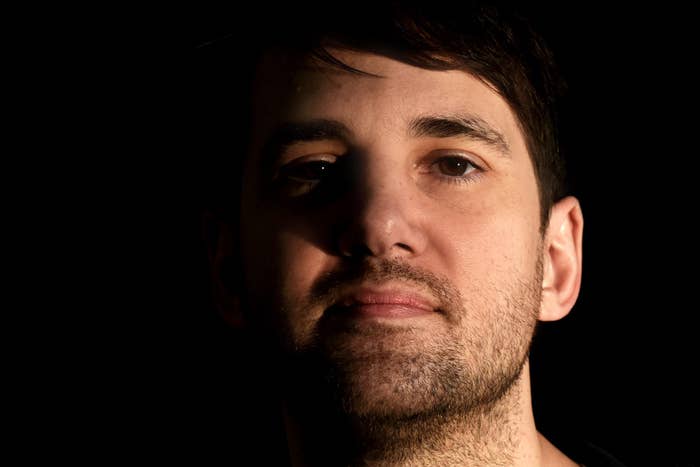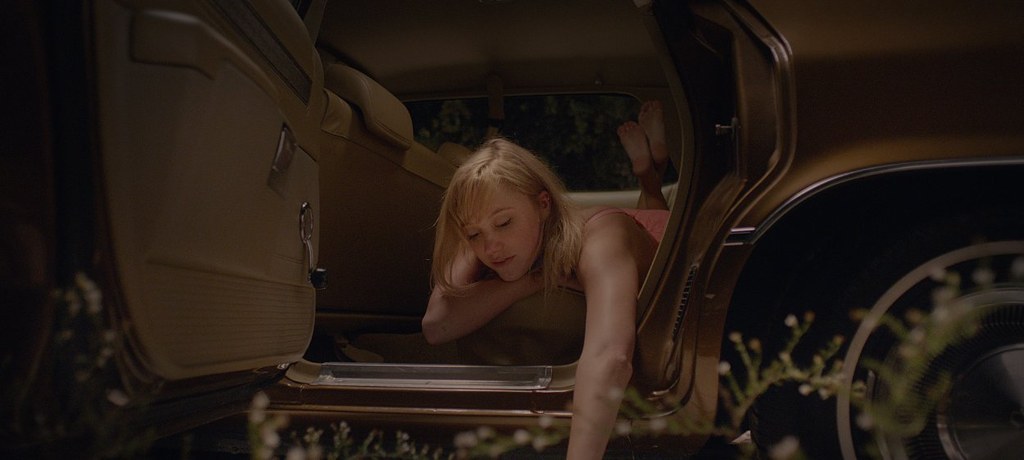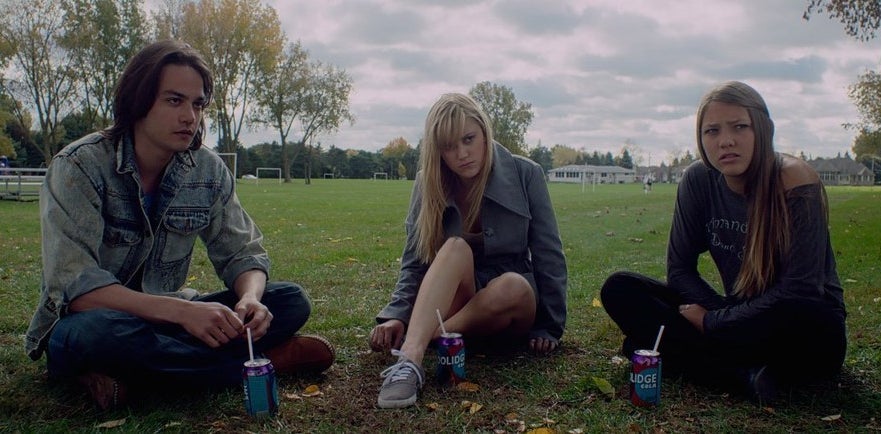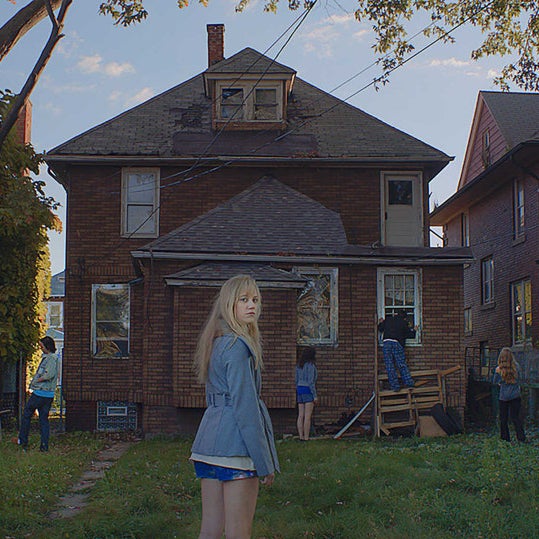
Some horror movies make you jump, while others resonate with a deeper kind of animal panic in your subconscious — and It Follows, the second film from writer-director David Robert Mitchell, certainly did for me. The night after I first saw it, I spent hours huddled in bed, sleepless and sweaty, still unable to get it out of my head. I couldn't decide if I felt better facing the window or the door — to keep an eye on what might be coming — though neither was actually that reassuring. One of the things It Follows emphasizes is that there's no real comfort in being able to see what's approaching if you can't stop it. There's only keeping track of where the exits are and hoping you don't eventually get exhausted from running away.
It Follows has lingered in my brain since its premiere at the 2014 Cannes Film Festival. Months have passed and it's screened at other major festivals, racking up praise, staking out that rare sweet spot where horror fans and art-house movie lovers intersect, and now finally making it to theaters in New York and Los Angeles on March 13. Unlike a lot of modern horror movies, It Follows goes light on the gore and startle-scares in favor of a more sustained and sometimes unexpectedly poetic dread — the kind that doesn't need to feel rational.
And there's nothing rational about its urban legend-style premise, which sounds awful on paper but works disturbingly well on screen: 19-year-old college student Jay (Maika Monroe), who lives at home in the Detroit suburbs, has been seeing a seemingly nice guy named Hugh (Jake Weary). In the lazy afterglow after they first have sex, he drugs her, ties her to a chair, and tells her that he was cursed, and he's just passed it along to her. There's this monster that will chase her now, and while no one else can see it, to Jay, it can look like anyone, like a stranger or a friend. It's slow, but it's inexorable; it will violently kill her if it catches her, and she can only pass it off by sleeping with someone else.


From the opening scene, in which we see what happens to someone who's caught by "it" before we ever know what "it" is, It Follows sets up a world tilted, just slightly, on its axis. It's one of long takes and carefully composed shots that have you scanning the background for menacing figures. "If we're watching a scene and we see into the distance and we know that danger is approaching, that feeling, that fear or that tension, that anxiety is going to last longer," Mitchell, who wrote and directed the movie, said in a recent interview at BuzzFeed's New York office.
He tried to avoid coming up with too much backstory for "it," even in his own head, to keep the focus on the experience of being haunted rather than the reasons for it. "These characters find themselves within a nightmare, and to inject logic to the origin of this nightmare is beside the point," Mitchell said.
And though It Follows is a doozy of a horror movie, Mitchell isn't a horror director. Teenagerdom is actually what his two films so far have in common, as well as the setting of the Detroit suburbs where he grew up. His 2010 debut was a wistful low-budget high school saga called The Myth of the American Sleepover — and It Follows plays like its deranged older brother.
Despite the movie being about a sexually transmitted haunting, Mitchell said It Follows is not some grand allegory in favor of keeping it in your pants and he was quick to point out that he wasn't trying to make "a puritanical statement." Sex may mark characters for death in a certain breed of slasher movie, but for Mitchell, it has more symbolic weight, a sign of maturity and some of the darkness that can come with it. "Growing up causes us to become aware of our mortality," he said. "As you get older, it's a natural part of life to become more aware of that. Ultimately, love and sex are ways in which we can at least temporarily push away death. We can't escape it in the same way that you can't completely get rid of it within the film, but it's a way we have of dealing with it."

The seeds of Mitchell's second feature actually come from his own childhood, and a recurring dream he used to have when he was 9 or 10, of something following him. "I knew it was a monster, but it looked like different people," Mitchell said. "It walked very slowly, and it would just be coming closer and closer. In one, I was playing on a jungle gym at recess with my friends, and I remember pointing over at this weird little boy in the distance. And no one knew what I was talking about, and I would run away from school. I'd get a block away, and I'd sit there, and he'd turn the corner.
"Knowing that I could get away, that it wasn't hard to run away, but it was always coming for me — it's a very heavy anxiety. That's what I built the film on, a cumulative dread."
It Follows has commonalities with some horror classics, particularly John Carpenter's work, but the eeriness of the way it captures that slippery, unawake sensibility is what sets it apart. "Usually, people telling their dreams is boring as all hell, let's be honest," Mitchell admitted. Instead, he built the film to strategically suggest a dream state. "We did that with some of the production design — there are things that are similar to our world, but a little outside of it. Things like the adults in the film being along the edges or not really being present. There's a mixture of anachronistic elements that are disconcerting. Something is a bit wrong."


That dreaminess is why Mitchell wanted to avoid too much explanation for what was following Jay as she tries to figure out a way to save herself with the help of her friends (played by Keir Gilchrist, Olivia Luccardi, Lili Sepe, and Daniel Zovatto). Though that may frustrate some viewers, it's also part of what makes It Follows so unsettling — Jay becomes more and more unmoored, never able to relax, all of the familiar things in her life no longer so known. The monster, or the promise of the monster, creeps into every aspect — her college campus, her childhood home, her neighborhood. It's impassive and unrelenting, and there are no sanctuaries.
She and her friends may look for answers, but there aren't necessarily any waiting for them. "I didn't want to make the film about a magical event because that's what it takes when you get to the bottom of something that feels outside of our normal experiences. To have a key moment that started it, some magical object or some terrible event, as opposed to being about the nightmare, it becomes about solving it. And that, for me, is often not as interesting," Mitchell said. "When you have a nightmare, there's no starting point. When you're within it, it's simply about trying to survive."
